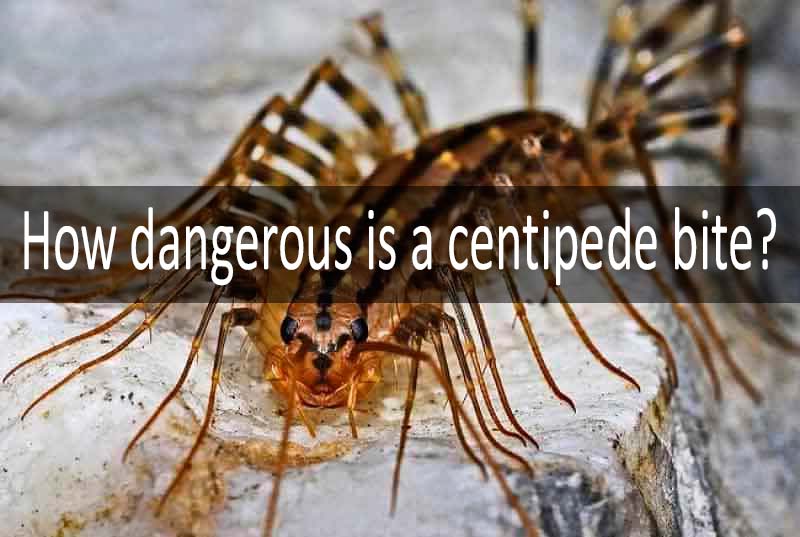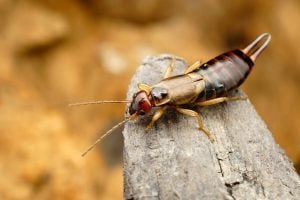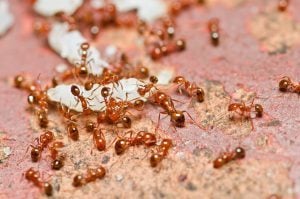Centipedes are not the most harmful pests to live nearby humans, but surely they are one of the nastiest and scariest ones. There are many reasons to be scared of them, including their high speed of movement, weird appearance and a chance to get bitten. How dangerous is a centipede bite? That is why quite often the elimination of centipedes turns into real hell for many people. We’re going to bust the myths surrounding the centipedes on the grounds of proven scientific data.
First, we’ll give you answers to the most common questions, such as “what does a centipede look like and where do they live?” Then we’ll find out whether the centipedes are poisonous and whether they bite. We’ll learn how many cases of centipede bites there were in the USA and what they ended with as well as what you should do in case you get bitten. But first let’s take a closer look at these disgusting creatures.
- F.A.Q. About the Centipedes
- Are Centipedes Venomous?
- Do Centipedes Bite?
- Everything You Should Know About Centipede Bites
- How to Get Rid Of Centipedes with 6 Best Sprays, Traps and Dusts for Killing Centipedes and Millipedes
What Do Centipedes Look Like, Where Do They Live, and How Many Legs Have They Got? F.A.Q. About the Centipedes
We’re surrounded by thousands of nasty centipedes. There are both the ordinary house centipedes and some quite dangerous monsters, such as an almost a foot-long giant scolopendra among them. Imagine yourself taking a bubble bath with a glass of wine and then this monstrous centipede appears out of nowhere!
{code 416}
We believe that everyone has seen a centipede close enough at least once. First people start panicking, screaming and run away in terror. They ask themselves the same questions: “What is this? How to get rid of this? Will it bite me?” Later some more sensible and serious questions come up. We’ve prepared the answers to them in order to clear the black spots in your understanding of eliminating these creatures. We have consulted the experienced and knowledgeable scientists of the Entomology Department of Pennsylvania. {code 371}
Let’s first sat that we can’t call them insects as scientifically both the centipedes and the insects are arthropods, but this is the only thing they have in common. The centipedes constitute a class of centipedes in the tracheal subtype. Most often you can encounter them in some dark and damp places outside, for instance, in a pile of leaves, under bark or stones, in the plant beds and mulch.

It’s not difficult to recognize these aliens. They only crawl at night or when it’s completely dark. The centipedes’ bodies are extremely mobile and clearly segmented: each segment has a pair of legs. The length of the legs increases as they get closer to the tail. You would ask why and we’ll reply that this helps the creature not to trip over itself and move quickly. Two venomous claws which are often mistaken for jaws are located on their head. There occur certain color variations, as usually they are grey with red, brown or pink, but some are striped yellow.
These species appeared in the USA in the middle of the 19th century and were brought from the Mediterranean region. They infested the households all over the place. Their bodies have grayish-yellow stripes, though brown prevails occasionally. Home centipedes can be scarcely called giants as they rarely grow longer than 2 inches.
Where do centipedes live?
Where can you encounter a regular centipede? Theoretically, it can fall on your face at night or crawl into the shower when you arrange home spa procedures. However, more often the centipedes settle in the warm and damp basements, dens and attics. They certainly love bathrooms and greenhouses and some remote areas. The specialists of the Department of Entomology, Pennsylvania recommend checking under the cement plates and inside any cracks, the hollow walls, in sewage and boxes with old things. It’s far easier to track a centipede at night as they are most active at that time.
How many legs does a centipede have?
Although the Latin prefix centi- means “a hundred”, the species spread in the USA have 30-354 legs. The funny rule is that the centipedes always have an odd number of pairs of legs (they have 5, 7, 9, 11, 13 or 15 pairs of legs). The house centipedes’ legs appear as they grow and as a rule they have 15 pairs of them. Surprisingly, the last pair of an adult female is the longest one, as it is twice as long as the insect’s body. Should you see a centipede with less than 30 legs, be aware that it is not grown up yet.
Are Centipedes Venomous?
Are centipedes poisonous? The specialists of the University of Georgia Cooperative Extension helped us deal with this controversial issue. According to them, the centipedes aren’t venomous but many types have venomous glands. The arthropods need it to paralyze the victim and consume it. The toxins also protect the centipedes from becoming someone’s lunch, as the substance exuded has an unpleasant odor which drives the predators far away.
Millipede vs Centipede
More precisely, it is the insects and slugs which hunt the centipedes and millipedes and not the humans that should be afraid of the toxic composition of a centipede’s repelling liquid. Nevertheless, they are likely to bite you if you encounter them. Still, the Georgian scientists calm down everyone who is worried and say that the “Millipedes and centipedes do not carry diseases that affect people, animals or plants”. They aren’t mosquitoes among which you can come across one infected with malaria, centipedes can’t do much harm to humans. Let’s elaborate with the help of particular examples.
- Millipedes

Many of these creatures have venomous glands on their sides. That’s why it’s not advisable to touch the millipedes with bare hands. Take care of your skin as their “protective spray” is rather pungent and blisters may appear on your hands. You shouldn’t rub the eyes after touching this creature either. Also, remember to wash your hands thoroughly.
- Centipedes

As a rule, all the centipedes have venomous glands behind the head. Among them there are some of the harmless types which inhabit the soil as well as the house centipedes which you can encounter at home.
- Scolopendra

The ones you should be afraid of are the largest centipedes (8-20 cm long), scolopendras. This is the centipede type that people should avoid. There have been several cases of humans getting bitten by them. The Wilderness Medical Society Wilderness Medical Society informs us that the scolopendra venom is similar to that of the scorpions! We’ll look into more details of that below. {code 371}
Do Centipedes Bite?
We’ll calm you down at once and state that millipedes don’t bite while centipedes do.
House centipede bite
However, don’t be afraid of consequences of a house centipede bite: although these centipedes don’t raise anything but disgust, they barely bite people. As for the animals, centipedes are likely to bite them, and the smaller the animal is, the harder it will take the bite. Still, this happens extremely rarely.
Scolopendra bite
Now let’s get into more details regarding the centipedes that bite the most. There were several cases of scolopendra bites in the US.
Are you afraid yet? Don’t be! The funniest thing is that 4 cases out of 5 involve the same person. A certain 36 years-old S.S was first bitten by a giant desert centipede, then by a 20-cm Scolopendra subspinipes while he was handling it for a television interview, then it bit him again within two days. For the last, fourth time he was bitten by a 10-cm while preparing for a class. We can therefore conclude that this scolopendra fan is likely an entomologist as he had an interview taken while handling it.
That’s why us, ordinary mortals, have nothing to fear:) The more so, the scientists claim that the scolopendras live presumably in the warm temperatures and tropical climate. In the United States they most often live in the Southern States, such as California, Arizona, Texas, Louisiana, Alabama, Kansas, Georgia, and Hawaii. The Northerners have nothing to fear at all unless they go on a vacation to the South. Beware in that case!
Everything You Should Know About Centipede Bites, From the Symptoms to the Treatment
Should you nevertheless get bitten by a scolopendra, be ready for the following consequences (we’ll warn you, they are not lethal). The bites can be extremely painful and they last long time (1-2 days) to heal. The main symptoms which can be revealed right after the bite are sharp and longing pain, it can range from being insignificant to being a “10” at a 1-10 pain scale. You may also get fever, feel extreme fatigue, the skin is likely to be extremely sensitive in the area of the bite, swelling and redness appears and later you can lose sensitivity and become numb.

Scolopendras are somehow similar to the wasps which don’t leave the sting in the wound and can sting a person several times in a row. Often this creature continues to pierce the human skin and thus envenoming you further even when detected. Usually the scolopendras bite you when you’re having a rest in your bed, but they can also crawl in the clothes and bite you when you get dressed.
The good news is that the scolopendra bites aren’t lethal. The Wilderness Medical Society scientists confirm this as ““No fatality due to a centipede sting has ever been reported in the United States”, although they still mention a single fatal bite case of a young Filipino girl. Being careful thus won’t do you harm. They also explain that “the contents of almost 1000 venom glands would be required for a fatal sting in an average adult” which doesn’t seem possible for any city dwellers.
Helpful tip: if you’re been bitten by a scolopendra, find a hot water bottle in the house, fill it with moderately hot water (not hotter than 113ºF) and put it over the place of bit. This simple measure is supposed to relieve the pain. The scientists have yet to explain this phenomenon, and they suspect that the possible reason for it is that some of the scolopendra venom components aren’t heat-resistance. Your second type of treatment is some ice and pain killers.
Are Centipedes Dangerous For Your House?
Don’t worry about your papers, furniture and other objects. Centipedes aren’t moths or silverfish. They aren’t interested in your belongings. On the other hand, some millipedes can make your house smell unpleasantly as “some species can secrete a foul-smelling fluid” which is highly unlikely, as you have to have too many of these arthropods at home so that you could feel this smell. Moreover, as the millipedes are herbivore scavengers, they might be interested in rotting wood, so we recommend you to check regularly whether it is too damp in your attics and basements and whether the millipedes will be able to feast on anything there.
We hope we haven’t scared you too much. So in order to compliment our antagonists in the end of the review, we would like to tell you how centipedes are useful. They actively destroy pests, as their diet includes bugs, flies, cockroaches, termites and even spiders. Sometimes the centipedes even guard your place from even more harmful creatures. That is why you’d better live in peace with them unless you fear them – or read our article about how to get rid of centipedes
{code 416}
{code 69} {code 371}






40 thoughts on “The Whole Truth about Centipedes Which Would Give You an Adrenaline Rush: Are Centipedes Poisonous? How dangerous are centipede bites? What Should You Do If You’re Bitten by a Centipede?”
Please tell me how to avoid a house centipede bite?
The main thing is not to panic! Despite its unpleasant appearance, this type of centipede is pretty harmless as long as you don’t touch them. If you behave aggressively and try to kill it or throw it out of the house, it may sting you in self-defense. So you should wear thick gloves and carefully take the house centipede out of the house. Done!
I got bit by a bark centipede and it had my whhole right though swollen the venom made me tgrow up 8 times, made me do numb in several lower extremities besides the local bite area. It also gave me a fever was extremely painful and itchy. I believe it bit me several times when it snuck into the shorts i wore with the head and hind legs. I felt really disarrayed fatigued itchy in pain nauseated etc…. it snuck in my gym bag in new jersey and followed me into ny.
While sleeping, I was bitten by a strange creature, and according to the symptoms described in this article, it was a centipede bite for sure – maybe it was a Scolopendra?
Scolopendra bites are not fatal. If you are lucky and the symptoms are only local – burning, swelling, pain in the place of the bite -you can handle it yourself. But if you feel weakness, high fever or even allergic symptoms like respiratory infection, you should ask for medical help to cope with the centipede bite.
when i was bitten or stung by the tail of a centipede in hawaii, my ankle swelled and it kept getting worse for a week, then got better by the end of two weeks. my neigbor was bitten on the toe and she said it hurt for a year. so the idea that your centipede bite will be fine in a couple of days is overly optimistic. also, pictures online suggest that serious gangeene infections can sometimes result from these bites. as for millipedes, their dead boides can stain things with a stain that i have been unable to wash out.
Wow! What a relief. I just killed one in my house now. Sleeping a hear my daughter cry shriekly and sharply like something bit her. I looked around but didn’t see anything, after about an hour and half, I saw a scary medium sized centipede crawling on the floor of the room and I angrily killed it. I rushed to inspect my daughter’s body but didn’t see any sign of bite. I actually goggled how to manage and treat a centipede bite before I read this that its not harmful anyway. I am so so relived. Thank you from Nigeria.
I just got bitte by a scolopendra while sleeping. At first, I thought it was just a red ant and shrugged it off my shoulder. That is when a second ‘bite’ occurred on my hand. The pain is a definate 10 out of 10. As the island I am on didnt have medical professionals, the police coast guard med evac me to a hospital where I was given 2 injections (painkiller and tetanus). Islanders informed me that once the swelling is over, the bitten area will get really itchy. Pulau Ubin, Singapore.
Scolopendra are nothing to be afraid of; unless you are allergic. Being from Tahiti, I get stung an average of once a year. These little bastards are everywhere on Pacific islands. I would not give the pain a 10 out of 10. More like a sharp 7, but that’s because I went through a fractured skull and I’d give that a 20/10. As a kid, scolopendras did hurt a lot. but as an adult, it is an easily manageable pain. there is no reason to go to the hospital or take pain killers. A good way to get the pain away if to spray any aerosole can product on the wound. Non toxic aerosole is recommended… but I survived spraying raids on it >.> (
Thanks for the informative article.I was bit by a scolopendra.Good information. Thank a million.
Just to touch on millipedes. Our home was in migration path of millipedes. Thousands came from the forest we live in and contracted at our plave. It has been 3 years and I have gotten numbers way down but still have sightings. It was so bad thought would have to burn house and start ovet. Tough little buggers and work in unison when they start releasing there toxins. Rough 4 years, 1 to figure it out.
Not too long i was bitten by that scary centipede in the mid night. So mildly painful that i had to source for this detailed information because my thought was that it’s lethal in nature. But the information ease me of fear. Thanking for you this piece of details. Though still going thru pain while typing this but am absolutely fearless. Please, allow me to have a relief balm and ice cube.??
I stepped on 8 inch centipede, dark purple, red head, yellow legs getting out of shower few days ago. It wrapped itself around my foot and stung,scratched, bit. It was fighting for its life. I was the one screaming like little girl. It let go, got away.couldnt find it.i sprayed. Good to know wouldn’t kill me,but felt like 10 bionic wasps stung me for couple days.
ive been playing with scolopendra all this time, great
I got stung by a centipede on the boney area of my big toe.
It hurt so bad I couldn’t think straight! I read on Google to put papaya on it, the enzymes of the papaya helps in the healing.
I let it dry n finally fell asleep. The next day the pain was gone. But now it itches, my ankle n on top of my foot is swollen. Now the itch n swelling is growing is going up my leg.
Is the venom responsible for the swelling n itch?
I would appreciate ur feedback, mahalo
I was awaken by an intense pain in my knuckle looked down and holy crap I was getting bite by this alien creature scolopendra centipede at least 12 inches long maybe bigger. Hurt like hell. I woke up swearing woke up the whole house this was not an average pain thought I was gonna die. I immediately washed the bite with hot water and vinegar it helped with the pain. Then I went on attack to find the alien creature turning on all the lights and equipped with a large hunting knife. Searched everywhere and found the scolopendra hiding under one of my socks damm thing was too big to hide under a sock so its flangs stuck out I moved the sock and stomped on it thinking yeah die biotch to my surprise after moving my foot the damm thing wasnt even hurt. Not wanting to get bit again I stomped and twisted this time and the creature was still alive and seamingly unhurt. So I stepped on this beast again holding it in place while exposing the head an cut off it head thinking now you dead you bugga. I swear this think was still moving so I went vegamatic on that thing sliced it into 6 pieces feeling like I been to war wit a bug but somehow satisflied I won da battle. Mahalo for letting me vent p.s. Don’t get bit by this creature it really hurts.
Just got nailed last night. The darn thing had crawled up my clothes and apparently was in my shirt. I sat down and when I leaned back i felt like like i leaned back on a hot nail. I jumped up and looked at the chair but there was nothing there then i felt it crawling in my shirt again. I didn’t know what it was yet but I had an idea. When i reached around and tried to stop it it got me again. Then and there I pulled of my shirt but didn’t see it anywhere. Thinking it might have gone into my pants I took them off then saw it trying to get away. I captured it in a bowl, took it outside and let go. Poor thing probably its world was coming to an end. We have a lot of centipedes on our property, but this is the first time I was ever bitten. It is an experience I don’t want to go through again. By morning the pain was mostly gone but the muscle in my back in the area of the bite was sore and felt swollen. Sure made for an interesting night. I sure hope the little critter is okay.
I got bitten by a scolopendra and it was a pain that I will never forget. What I kept wondering about till now is the way that pain disappered within 3 hous. I tried applying different things on my bitten hand but the pain never leave me…till I saw a bottle of Jonny Walker and I drunk only 1 full glass. And that was the medicine. The pain disappered intantly.
*Help please!* Okay so I have a small one- approx 4 inches- in a jar. I don’t like to kill things if I can avoid it. Anyway my huge concern is that I found it because my cat was messing with it. He often plays with lizards to death (unless I can rescue them). I’m afraid he was bitten (even though he didn’t make pain noises). I know it’s not fatal to humans but what about a 10 pound cat? Possibly bitten in the mouth? Help please!!!
i rinsed my mouth with water dat have a dead centiped. though i didnt drink it. am afraid of dieing cos i felt i swallow a percentage of the water. can drinking water that have a dead centiped kills.? please help
I saw a black 6 inches scolopendra just last night while I was about going to bed on a wall. Scary in nature and it took a longer time to get rid of it. I sprayed a very strong insecticide on it but it seems not having effect so I decided to hit its head with a wood and uptil the morning it was still breathing.
In Negril got bitten while sleeping, apparently a row of theee bites, on my left palm. Woke up thinking I somehow sprained my humb while sleeping in a wrong position or something. Made a splint out of bamboo until later that afternoon it started to radiate down my wrist and throbbing. The locals immediately doused the area in Jamaican rum, then iodine, and went down to get some bees it root and made a tonic for me to chug down to remove venom. Ice! Purple veins now gone. We’ll see tomorrow!
In Negril got bitten while sleeping, apparently a row of theee bites, on my left palm. Woke up thinking I somehow sprained my humb while sleeping in a wrong position or something. Made a splint out of bamboo until later that afternoon it started to radiate down my wrist and throbbing. The locals immediately doused the area in Jamaican rum, then iodine, and went down to get some bees it root and made a tonic for me to chug down to remove venom. Ice! Purple veins now gone. We’ll see tomorrow!
I was bitten by the scolopendra while vacationing in Texas. The bugger snuck into my bed in the middle of the night and bit me on the cock! I was in agony for 3 hours, but the next day my cock was swollen 3x its normal size so my gf took advantage of that and made sure she sucked out any venom that could have been leftover from the day before.
this centipede just bite my finger when I touched my charger then I drop my tablet and crushed the centipede
I am happy to hear that these centipedes are not dangerous at all- though they look terrible Thanks a lot for such usefull article, now I know what to do if I see these beasts again
I just got bitten on my neck while i was sleeping and its 4.14am in the morning, all the medical shop are closed..m really very scared that sth might happen to me since its too painful
I was bitten twice about two weeks ago by a centipede and let me tell you it wasn’t very pleasant. Within about 15 minutes my body totally was bright red and I broke out in hives. At that point in went into shock and had to be rushed to an emergency hospital where I received massive shots of Benadryl and steroids to counter act the poison. The doctor stated that if I had waited another hour to come in they couldn’t have saved me. It’s not the type of insect poisoning but how your body reacts.
The Scolopendra are all around our area and an average of 20 come inside between June & September, w/ odd ones even in March.
We’re near Santa Fe NM; the largest I’ve seen was about 7 or 8 inches. This is the last year we’ll be here thank God. Every night I feel like I’m in a war zone & don’t sleep til dawn. But I haven’t been bitten yet.
Freaked out now because I’ve seen three of them climb up walls, vs being only on the floor.
Anyway, thank you for your article; helps me feel less alone.
I was persuaded by my husband to go on vacation to Hawaii! From his words, there is very beautiful, just like from movies or fairy tales. I succumbed to his stories and we bought tickets. At first, rest went according to plan, but who knew that in Hawaii, huge centipedes are the norm! Lord! I swear this place! They are everywhere, we settled in some hotel, there is a forest nearby, or something like that. Always wondered, do centipede bite? Hope – no!
Oh Godness! I just saw a cendipede crawled in the basement floor when I was vacooming. it scared me! then I googled it and found this blog, thank you so much for this article from me. I am Indonesian but lived in Toronto. This is the first time I see this kind of animal. Thank you though!
Coyote Peterson (check him out on YouTube) was bitten by a giant desert centipede. He said the pain was far worse than a bullet ant and an executioner wasp sting, and that it was the worst sting he’s ever had. He was put under intensive care for the first time after a sting/bite. Check out his video for non-anecdotal evidence and do avoid giant centipedes like, I don’t know, a raging T-Rex that is hell bent on eating you for dinner.
I just got bitten by a centipede.
I was so restless and afraid!
But this article really cheered me up, smiles….
I’m glad to know that they aren’t poisonous
Just got a love bite from one of these at 2.30am. We live in Barbados it measured about 12cm very painful and I have a strong pain threshold!
Was bitten several times in bed at 6:30 am today and yes!!!… it hurt baaaddd!
But after two ibuprofen and some more rest, I feel fine. Glad they’re not lethal.
God bless.
I just got bitten by this little freak at 3:00am. It hurts but tolerable. Luckily, it wasn’t my 2yo daughter sleeping beside me who got bitten. I’m freaking out actually as I feel like my hand is getting numb, or was I just overthinking. It’s raining that’s why these little suckers crawl inside the house. Now I can’t go back to sleep. I’m paranoid thinking another one might crawl up on us again.
I was bitten at around 2:30am, I was wondering on how to get helped but thanks to God I googled and reached to this site thanks I have realised it’s not that poisonous as I thought before
I always catch centipedes in my bed crawling inside my cloths or arm and at my neck they are 1inches long, luckily it doesn’t bite me . But just today I got bitten in bed at 2:30am 3 times its very painful. My finger got inflamed i wash and took a antihistamine right away.
Have just killed one today unknowingly that they r not that dangerous. But many people out there they strongly believe that they are much dangerous n deadly including me.
Using herbal natural remedy was what got me tested negative to HSV 2 after been diagnosed for years.I have spend so much funds on medications like acyclovir (Zovirax), Famciclovir (Famvir), and Valacyclovir (Valtrex But it was all a waste of time and my symptoms got worse To me It is very bad what Big pharma are doing, why keep making humans suffer greatly just to get profits annually for medications that doesn’t work.I’m glad that herbal remedies is gaining so much awareness and many people are getting off medications and activating their entire body system with natural herbal remedies and they are become holistically healed totally.